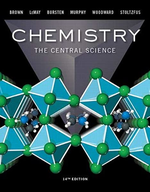?Alcohol-based fuels for automobiles lead to the production of formaldehyde \(\left(\mathrm{CH}_{2} \mathrm{O}\right)\) in exhaust gases. Formaldehyde
Chapter 18, Problem 18.33(choose chapter or problem)
Alcohol-based fuels for automobiles lead to the production of formaldehyde \(\left(\mathrm{CH}_{2} \mathrm{O}\right)\) in exhaust gases. Formaldehyde undergoes photodissociation, which contributes to photochemical smog:
\(\mathrm{CH}_{2} \mathrm{O}+h v \longrightarrow \mathrm{CHO}+\mathrm{H}\)
The maximum wavelength of light that can cause this reaction is 335 nm.
(a) In what part of the electromagnetic spectrum is light with this wavelength found?
(b) What is the maximum strength of a bond, in kJ/mol, that can be broken by absorption of a photon of 335-nm light?
(c) Compare your answer from part (b) to the appropriate value from Table 8.3. What do you conclude about C-H bond energy in formaldehyde?
(d) Write out the formaldehyde photodissociation reaction, showing Lewis-dot structures.
Text Transcription:
(CH_2O)
CH_2O + hn \longrightarrow CHO + H
Unfortunately, we don't have that question answered yet. But you can get it answered in just 5 hours by Logging in or Becoming a subscriber.
Becoming a subscriber
Or look for another answer
